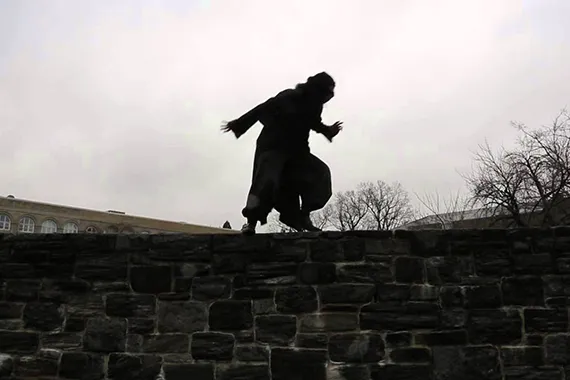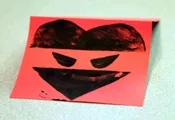Students Spread Valentine's Day Love with Ninjagrams

A ninja in stealth mode, as captured in this video.
Whether Valentine’s Day at Swarthmore means chocolate and roses or Chomsky and regression analysis, the most exciting part of this midwinter holiday is bound to be the masked ninjas who interrupt it all. Yes, ninjas.
Each year around Valentine’s Day, a corps of students in stealthy black garb lay loving siege upon a not-really-unsuspecting campus. Their mission is to deliver homemade truffles and Valentine’s cards – ninjagrams – which students hand-write for a designated recipient, by the most epic means available.
This year’s ninjagram delivery takes place on Friday, Feb. 13, the day before Valentine’s proper. At the height of a weekday morning as they infiltrate the corridors, seminar classrooms, lecture halls, and dorm rooms so routinely trodden throughout the year, these warrior cupids turn the routine into the romantic.
For the ninjas, it's a labor of love. The process began earlier this month, well under the radar. Coordinated by Master Ninja Raymond Elias ’15, ninjas have discerningly recruited new ranks to their operation; crafted the signature red cards and ninja insignia that are ubiquitous with this tradition; baking truffles, which are offered for purchase along with the cards; and, most importantly, spent days stationed in the Sharples Dining Hall vestibule selling these ninjagrams and readying them for delivery.

A tradition of creativity guides the ninjas through every step, with deep roots to an ancient Swarthmore that existed before Moodle or the Matchbox. According to Elias, who is a a computer science and linguistics major from Brooklyn, N.Y., a lengthy origin myth was developed in 2007, declaring Swarthmore’s ninjagrams the endpoint of a quest to find the legendary Awesome Ninja, who was prophesized in the sixth century. The ninjas’ charismatic tendency toward the spectacular does not end with this myth. It shapes their present understandings of what they do, and keeps them excitedly involved year after year. And it will become most apparent, of course, on the big day.
Riley Collins ’16, a computer science and linguistics major from Ridgeland, Miss. and seasoned ninja, explains that "once a card is given to a ninja, it is their sacred duty to make sure it gets delivered; ninjas are sprinting all over campus to make sure that their duty is done.” The base of this operation is Ninja Central, known during the rest of the year as the Science Center’s Eldridge Commons, where organizational and logistical tasks are determined. But its real heart is what takes place everywhere else, the physical deliveries.
“I've lain in wait in a prop coffin,” says Elias of his experiences conveying ninjagrams, “danced with a potted plant on my head to Mariachi music, and died dramatically more times than I can recount. It never gets dull.” Speaking of his own experiences, Collins adds, “I've seen ninjas roll themselves up in rugs, scale the side of a building… During [Professor Craig Williamson’s Tolkein Pullman class], one ninja put on the soundtrack from the Lord of the Rings movies while 13 others reenacted the bridge of Khazadum scene from the movies – with Professor Williamson as Gandalf.” [Watch this and more in this video by Ethan Bogdan '15]
For a particularly creative touch, a student can also purchase “ninsurance” with a ninjagram. Elias elaborates that with ninsurance, “when another ninja appears to deliver your card - which is very threatening, of course - the bodyguard will leap from the shadows and engage the other ninja in a duel to the death, possibly in dramatic slow motion. The victor delivers the ninjagram.”
What ultimately guides the ninjas is also what makes this tradition so fundamentally Swarthmore, even more than students rolling around classroom floors with foam swords: its continual commitment to social action. Each year, all proceeds from the card, chocolate, and insurance sales go to a charity organization that the ninjas collectively select. This year, all funds raised will support Global Neighbors, an organization run exclusively by Swarthmore students that helps individuals both locally and internationally who live with disabilities and disease.
“Students here want to do cool fun things, but they want what they are doing to matter in a larger context,” says Collins. “That's why I find Ninjagrams satisfying. Yes, I get to run, crawl, creep, and jump around campus in a silly costume while delivering cards - which is great, but that means nothing if its not for a good cause.”



